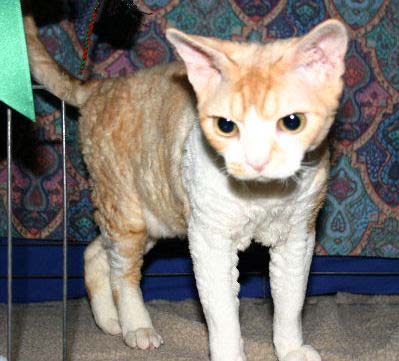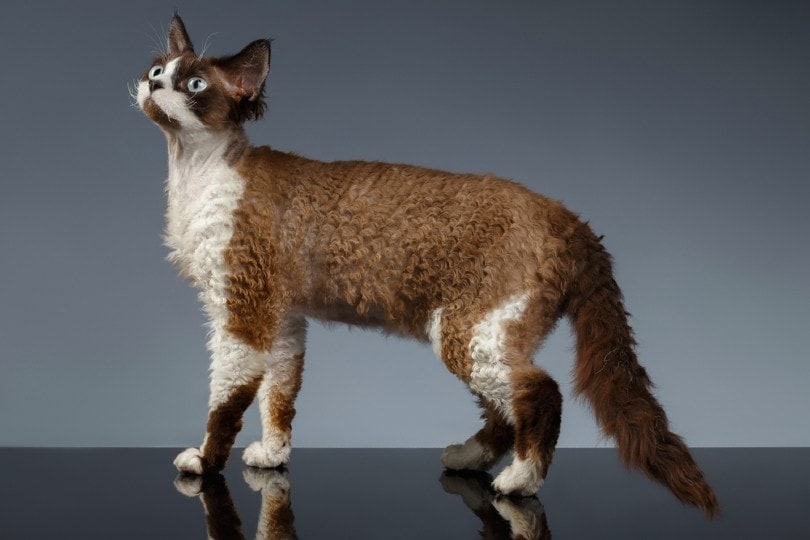
The Devon Rex Cat is also known as the “Pixie Cat” for its elf-like features!
The Devon Rex is an an affectionate, active cat that makes it a great family pet. This interesting breed is uniquely different from most other cat breeds. Its principal feature is a wavy coat made of down hairs, the undercoat, along with a few guard hairs that give it a very attractive texture. Along with its pretty coat, this cat also stands out with very distinctive ears. The ears are extremely large and wide-set, giving it a “pixie” or “elfish” appearance, and thus the nickname, Pixie Cat.
The build of the Devon Rex cat has several other interesting and unique features. It has a hard and muscular, yet slender body with a broad chest. Both its tail and legs are long and slender, but the hind legs are longer than the front ones. The front legs also come out of the chest in a “bull-dog” type fashion. This very unusual combination of distinctive features has led to another, equally unusual nickname, the “Alien Cat”.
The Devon Rex Cat is a wonderful breed that requires very little maintenance. For people who are allergic to cats, this breed along with a similar breed, the Cornish Rex, are cats that are less likely than other cat breeds to cause an allergic reaction. Like the Cornish Rex, the Devon Rexes enjoy being indoors and require minimal grooming. In fact, the most grooming this cat usually needs is an occasional wiping down of its coat with a damp cloth, and washing its ears.
Both the Cornish Rex and the Devon Rex are mutation breed cats with a wavy, low allergenic type coat, but they each have a different gene that’s responsible for their curly coats. Their coats are also slightly different in looks. Because of the additions of guard hairs on the Devon Rex, its coat is a little rougher and has a more “lumpy” appearance. This cat is a great indoor breed for all sorts of people who enjoy playing and spending time with their cats.
The Devon Rex is a loving, social cat, especially with people. In general, it is friendly with dogs, other cats, and even rodents, but it enjoys being with people the most. They are gentle cats that are good playmates for cat-friendly children. The Devon Rexes are active and playful, but not as much as the Cornish Rex. Yet they are known for remaining playful even throughout their later years.
Unlike some breeds, this breed does not need time to itself. It enjoys being around people most of the time. Devon Rexes have been described as “dog-like”, due to their friendly, human-centered demeanor and various tricks that have been observed in this breed. Some have been taught to fetch slippers and walk on a leash. They have also been observed wagging their tails, but it is now believed that the wagging may actually be serving the purpose of balancing them when they performed difficult tricks, such as walking a tightrope. They have a soft, sweet voice, milder than the Cornish Rex’s.
The Devon Rex started out as a mutation breed cat. It originated in 1960 as a spontaneous genetic mutation from a stray tomcat mating with a tortie-and-white stray in Devon, England. Their litter produced one curly haired kitten. This kitten, named Kirlee, is known as the father of the Devon Rex breed. Today this cat breed can be found in England, the United States, Australia, and elsewhere.
For information about keeping a pet cat, see:
Cat Care: How to Take Care of a Cat
- Kingdom: Animalia
- Phylum: Chordata
- Class: Mammalia
- Order: Carnivora
- Family: Felidae
- Genus: Felis
- Species: domesticus
Background
The Devon Rex line is believed to have descended from a stray tomcat that was seen around an old tin mine in Buckfastleigh in Devon. The cat appeared to have a curly coat which enticed various people to attempt to capture and breed him, but they were not successful. However, in 1960 the cat mated with another stray, a tortie-and-white, which reared a litter that included one curly-haired kitten. This kitten was named Kirlee by Miss Beryl Cox, a friend of the kittens mother. Kirlee is known as the father of the Devon Rex breed.
At first, it was believed that these cats could be bred with the Cornish Rex breed, which was discovered ten years earlier. However, when they were bred together, only straight-haired kittens were produced, revealing that the two breeds were distinctive. It was also found that curly-haired kittens from the Devon Rex line could only be produced when both parents carried the recessive gene.
The Devon Rex was recognized as a separate breed from the Cornish Rex in 1967, except in the United States, which waited until 1979 to distinguish the two breeds. Common names for this cat breed include Devon Rex, Pixie Cat, and Alien Cat.
Description
Like the Cornish Rex, the Devon Rex is largely known for its unique wavy coat. The Devon Rex coat is comprised mostly of down hairs, but unlike the Cornish Rex, it has some guard hairs, though they are thinner than the average cat’s guard hairs and vary in length. These features create a lumpier, slightly harsher coat than the Cornish Rex coat. Like the Cornish Rex, the Devon Rex also has curly eyebrows and whiskers. Interestingly, like young birds Devon Rex kittens molt their original coat, which is a very fine down coat, at around 8 weeks of age. The new coat can take from a few days to over a year to completely grow in.
The Devon Rex is a small to medium-sized cat, weighing 6 to 9 pounds. It has a hard, muscular build and a slender body, though its chest is broad. The legs are slender, but strong. The hind legs are longer than the front legs and the front legs come out from the chest, giving it a bulldog pose. The tail is long and slender. The head is wedge-shaped with full cheeks, large, oval-shaped, large set eyes, a stop to the nose, creating a dip when seen from the profile, and extremely large, wide-set ears, giving it a “pixie” or “elfish” appearance. The lifespan for a Devon Rex is 9 to 15 years, though some have been known to reach 20 years of age.
Care and Feeding
Devon Rexes enjoy eating a lot, but they are not known for over-eating. No special diet is required.
Housing Your Cat
Like the Cornish Rex, the Devon Rex enjoys being inside. It can be a great apartment cat because it does not seem to require time outside. This breed may need additional warmth during cool weather, such as heating pads or blankets. Of course, they also like to snuggle up in their owner’s lap, enjoying the added body heat.
Maintenance
This breed requires little grooming. It is advisable to wipe the coat down, especially on the ears, with a damp cloth once a week in order to remove excess dirt and oils and increase the coat’s wave.
Social Behaviors
This breed enjoys being around people and other animals, though it prefers the company of humans to other animals. It is an extroverted, social breed that does not enjoy being alone. It is advisable to keep at least one playmate for your Devon Rex if the cat is going to be alone for extended periods of time in the house. Some Devon Rexes have been known to exhibit destructive behaviors, such as shredding curtains, when left with no company.
Activities
The Devon Rex is a naturally energetic, playful cat. It enjoys jumping and performing various acrobatics. It is known for being playful throughout its days, and should be provided with a variety of fun toys to play with.
Breeding/Reproduction
This breed has been bred with Siamese, British Burmese, Persians, and British Shorthairs. Breeders continue to breed them with other breeds, producing only straight-haired kittens in the first litter and some curly-haired kittens in the following litters, since both parents need to possess the gene in order to produce a curly-haired kitten. Litters contain 3 to 5 kittens. Like the Cornish Rex, Devon Rexes are excellent mothers.
Common Health Problems
The Devon Rex should be kept inside during cold weather and provided with additional warmth, since its thin coat is often not a sufficient insulator. In the early history of the breed, a hereditary, fatal disease known as “spasticity” was developed, due to inbreeding. However, it has been bred out of current lines. Also, muscular dystrophy and hemophilia have been seen in some Devon Rexes, but breeders have attempted to breed these diseases out.
Availability
This breed can be found from breeders on the internet or in your local area. The price of a Devon Rex ranges from about $200 to $1200.
References
- See Animal-World References: Cat Breeds – Exotic Cats
- Bruce Fogle, CATolog, DK ADULT, 2002.
- Mordecai Siegal, Simon & Schuster’s Guide To Cats , Simon & Schuster, 1983
Featured Image Credit: Seregraff, Shutterstock
